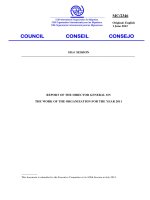AN0566 using the PORTB interrupt on change as an external interrupt
Bạn đang xem bản rút gọn của tài liệu. Xem và tải ngay bản đầy đủ của tài liệu tại đây (98.87 KB, 7 trang )
M
AN566
Using the PORTB Interrupt on Change as an External Interrupt
Author:
Mark Palmer
Microchip Technology Inc.
INTRODUCTION
The PICmicro™ families of RISC microcontrollers are
designed to provide advanced performance and a
cost-effective solution for a variety of applications. To
address these applications, there is the PIC16CXXX
microcontroller family of products. This family has
numerous peripheral and special features to better
address user applications.
The feature this application note will focus on is the
Interrupt on Change of the PORTB pins. This “interrupt
on change” is triggered when any of the RB7:RB4 pins,
configured as an input, changes level. When this interrupt is used in conjunction with the software
programmable weak internal pull-ups, a direct interface
to a keypad is possible. This is shown in application
note AN552, Implementing Wake-up on Key Stroke.
Another way to use the “interrupt on change” feature
would be as additional external interrupt sources. This
allows PIC16CXXX devices to support multiple external
interrupts, in addition to the built-in external interrupt on
the INT pin.
USING A PORTB INPUT FOR AN
EXTERNAL INTERRUPT
The interrupt source(s) cannot simply be directly
connected to the PORTB pins, and expect an interrupt
to occur the same as on the interrupt (INT) pin. To
develop the microcontrollers hardware/software to act
as an interrupt by an external signal, we must know the
characteristics of the external signal. After we know
this, we can determine the best way to structure the
program to handle this signal. The characteristics that
we need to consider when developing the interrupt
include:
1.
2.
The rising edge and falling edges.
The pulse width of the interrupt trigger (high time
/ low time).
It is easy to understand the need of knowing about
which edge triggers the interrupt service routine for the
external interrupt. This allows one to ensure that the
interrupt service routine is only entered for the desired
edge, with all other edges ignored. Not so clear is the
pulse width of the interrupt’s trigger. This characteristic
helps determine the amount of additional overhead that
the software routine may need.
This application note will discuss some of the issues in
using PORTB as additional external interrupt pins, and
will show some examples. These examples can be easily modified to suit your particular needs.
1997 Microchip Technology Inc.
DS00566B-page 1
AN566
Figure 1 shows the two cases for the interrupt signal
verses the time to complete the interrupt service
routine. The first waveform is when the signal makes
the low-to-high-to-low transitions before the interrupt
service routine has completed (interrupt flag cleared).
When the interrupt flag has been cleared, the interrupt
signal has already returned to the inactive level. The
next transition of the signal is due to another interrupt
request. An interrupt signal with this characteristic will
be called a small pulse width signal.
The second waveform is when the signal only makes
the low-to-high transitions before the interrupt service
routine has completed (interrupt flag cleared). The next
transition (high-to-low) will return the interrupt signal to
the inactive level. This will generate a “false” interrupt,
that will need to be cleared. Then the following
FIGURE 1:
transition (low-to-high) will be a “true” interrupt. An
interrupt signal with this characteristic will be called a
wide pulse width signal.
An interrupt pulse with a small pulse width requires less
overhead than a wide pulse width. A small pulse width
signal must be less than the minimum execution time of
the interrupt service routine, while a wide pulse width
must be greater then the maximum time through the
interrupt service routine.
Example 1 shows a single interrupt source on PORTB
(RB7), which executes the interrupt service routine on
a rising edge. The interrupt source has a small pulse
width. In this case, since the interrupt pulse width is
small, the pulse has gone high and then low again
before PORTB is read to end the mismatch condition.
So when PORTB is read it will read a low signal and will
again be waiting for the rising edge transition.
INTERRUPT STEPS FOR SMALL AND WIDE PULSE WIDTHS
Small Pulse Width
RBx
Rising Edge
Triggers Interrupt
PORTB Interrupt Service Routine is complete.
PORTB Interrupt Flag is cleared, mismatch is ended.
Wait for next interrupt edge.
Signal returns to “Inactive State”.
Large Pulse Width
RBx
Rising Edge
Triggers Interrupt
PORTB Interrupt Service Routine is complete.
PORTB Interrupt Flag is cleared, mismatch is ended.
Wait for next interrupt edge.
Falling Edge
Triggers “False” Interrupt
PORTB Interrupt Service Routine is complete.
PORTB Interrupt Flag is cleared, mismatch is ended.
Wait for “False” interrupt edge.
EXAMPLE 1:
SINGLE INTERRUPT WITH A SMALL PULSE WIDTH
PER_INT
BTFSS
GOTO
CLR_RBINTF
MOVF
BCF
RETFIE
OTHER_INT
INTCON, RBIF
:
:
RETFIE
DS00566B-page 2
INTCON, RBIF
OTHER_INT
:
:
PORTB, 1
;
;
;
;
;
;
;
;
;
PortB interrupt?
Other interrupt
Do task for INT on RB7
Read PortB (to itself) to end
mismatch condition
Clear the RB interrupt flag.
Return from interrupt
Do what you need to here
; Return from interrupt
1997 Microchip Technology Inc.
AN566
Example 2 shows a single interrupt source on PORTB
(RB7), which executes the interrupt service routine on a
rising edge. The interrupt source has a wide pulse width.
In this case since the interrupt pulse width is large, the
pulse is still high before PORTB is read to end the
mismatch condition. So when PORTB is read it will read
a high signal and will generate an interrupt on the next
falling edge transition (which should be ignored).
EXAMPLE 2:
SINGLE INTERRUPT WITH A WIDE PULSE WIDTH
PER_INT
BTFSS
GOTO
BTFSC
GOTO
:
INTCON, RBIF
OTHER_INT
PORTB, RB7
CLR_RBINTF
:
:
PORTB, 1
CLR_RBINTF
MOVF
OTHER_INT
BCF
INTCON, RBIF
RETFIE
:
:
RETFIE
;
;
;
;
;
;
PortB interrupt?
Other interrupt
Check for rising edge
Falling edge, clear PortB int
flag
Do task for INT on RB7
;
;
;
;
;
Read PortB (to itself) to end
mismatch condition
Clear the RB interrupt flag.
Return from interrupt
Do what you need to here
; Return from interrupt
Example 3 shows an interrupt on change with the
interrupt source on PORTB (RB7). This executes the
interrupt service routine on a both edges. The interrupt
source must have a minimum pulse width to ensure that
both edges can be “seen”. The minimum pulse width is
the maximum time from the interrupt edge to the reading of PORTB and clearing the interrupt flag.
EXAMPLE 3:
INTERRUPT ON CHANGE
PER_INT
CLR_RBINTF
BTFSS
GOTO
MOVF
INTCON, RBIF
OTHER_INT
PORTB, 1
BCF
INTCON, RBIF
:
:
RETFIE
OTHER_INT
;
;
;
;
;
;
;
;
;
PortB interrupt?
Other interrupt
Read PortB (to itself) to end
mismatch condition
Clear the RB interrupt flag.
Do task for INT on RB7
Return from interrupt
Do what you need to here
:
RETFIE
1997 Microchip Technology Inc.
; Return from interrupt
DS00566B-page 3
AN566
USING PORTB INPUTS FOR
MULTIPLE INTERRUPTS
SUMMARY
The previous examples have been for a single external
interrupt on PORTB. This can be extended to support up
to four external interrupts. To do this requires additional
software overhead, to determine which of the PORTB
pins (RB7:RB4) caused the interrupt. Care should be
taken in the software to ensure that no interrupts are lost.
In this example, the interrupt sources on RB7, RB5, and
RB4 have a small pulse width, while the interrupt
source on pin RB6 is wide and should cause a trigger
on the rising edge.
EXAMPLE 4:
PER_INT
The PORTB interrupt on change feature is both a very
convenient method for direct interfacing to an external
keypad, with no additional components, but is also
versatile in its uses the ability to add up to four
additional external interrupts. Of course hybrid solutions are also possible. That is, for example, using
PORTB<6:1> as a 3x3 keypad, with PORTB<7> as an
external interrupt and PORTB<0> as a general purpose
I/O. The flexibility of this feature allows the user to
implement a best fit design for the application.
MULTIPLE INTERRUPTS WITH DIFFERENT PULSE WIDTHS
BTFSS
GOTO
INTCON, RBIF
OTHER_INT
; PortB interrupt?
; Other interrupt
;
; PortB change interrupt has occurred. Must determine which pin caused
; interrupt and do appropriate action. That is service the interrupt,
; or clear flags due to other edge.
;
MOVF
PORTB, 0
; Move PortB value to the W register
;
This ends mismatch conditions
MOVWF
TEMP
; Need to save the PortB reading.
XORWF
LASTPB, 1
; XOR last PortB value with the new
;
PortB value.
CK_RB7
BTFSC
LASTPB, RB7
; Did pin RB7 change
CALL
RB7_CHG
; RB7 changed and caused the interrupt
CK_RB6
BTFSC
LASTPB, RB6
; Did pin RB6 change
CALL
RB6_CHG
; RB6 changed and caused the interrupt
CK_RB5
BTFSC
LASTPB, RB5
; Did pin RB5 change
CALL
RB5_CHG
; RB5 changed and caused the interrupt
CK_RB4
BTFSC
LASTPB, RB4
; Did pin RB4 change
GOTO
RB4_CHG
; RB4 changed and caused the interrupt
;
RB7_CHG
:
; Do task for INT on RB7
:
;
RETURN
RB6_CHG
BTFSC
PORTB, RB6
; Check for rising edge
RETURN
; Falling edge, Ignore
:
; Do task for INT on RB6
:
RETURN
RB5_CHG
:
; Do task for INT on RB5
:
;
RETURN
RB4_CHG
:
; Do task for INT on RB4
:
;
CLR_RBINTF
MOVF
TEMP, 0
; Move the PortB read value to the
MOVWF
LASTPB
;
register LASTPB
BCF
INTCON, RBIF
; Clear the RB interrupt flag.
RETFIE
; Return from interrupt
;
OTHER_INT
:
; Do what you need to here
:
RETFIE
; Return from interrupt
DS00566B-page 4
1997 Microchip Technology Inc.
Note the following details of the code protection feature on PICmicro® MCUs.
•
•
•
•
•
•
The PICmicro family meets the specifications contained in the Microchip Data Sheet.
Microchip believes that its family of PICmicro microcontrollers is one of the most secure products of its kind on the market today,
when used in the intended manner and under normal conditions.
There are dishonest and possibly illegal methods used to breach the code protection feature. All of these methods, to our knowledge, require using the PICmicro microcontroller in a manner outside the operating specifications contained in the data sheet.
The person doing so may be engaged in theft of intellectual property.
Microchip is willing to work with the customer who is concerned about the integrity of their code.
Neither Microchip nor any other semiconductor manufacturer can guarantee the security of their code. Code protection does not
mean that we are guaranteeing the product as “unbreakable”.
Code protection is constantly evolving. We at Microchip are committed to continuously improving the code protection features of
our product.
If you have any further questions about this matter, please contact the local sales office nearest to you.
Information contained in this publication regarding device
applications and the like is intended through suggestion only
and may be superseded by updates. It is your responsibility to
ensure that your application meets with your specifications.
No representation or warranty is given and no liability is
assumed by Microchip Technology Incorporated with respect
to the accuracy or use of such information, or infringement of
patents or other intellectual property rights arising from such
use or otherwise. Use of Microchip’s products as critical components in life support systems is not authorized except with
express written approval by Microchip. No licenses are conveyed, implicitly or otherwise, under any intellectual property
rights.
Trademarks
The Microchip name and logo, the Microchip logo, FilterLab,
KEELOQ, microID, MPLAB, PIC, PICmicro, PICMASTER,
PICSTART, PRO MATE, SEEVAL and The Embedded Control
Solutions Company are registered trademarks of Microchip Technology Incorporated in the U.S.A. and other countries.
dsPIC, ECONOMONITOR, FanSense, FlexROM, fuzzyLAB,
In-Circuit Serial Programming, ICSP, ICEPIC, microPort,
Migratable Memory, MPASM, MPLIB, MPLINK, MPSIM,
MXDEV, PICC, PICDEM, PICDEM.net, rfPIC, Select Mode
and Total Endurance are trademarks of Microchip Technology
Incorporated in the U.S.A.
Serialized Quick Turn Programming (SQTP) is a service mark
of Microchip Technology Incorporated in the U.S.A.
All other trademarks mentioned herein are property of their
respective companies.
© 2002, Microchip Technology Incorporated, Printed in the
U.S.A., All Rights Reserved.
Printed on recycled paper.
Microchip received QS-9000 quality system
certification for its worldwide headquarters,
design and wafer fabrication facilities in
Chandler and Tempe, Arizona in July 1999. The
Company’s quality system processes and
procedures are QS-9000 compliant for its
PICmicro® 8-bit MCUs, KEELOQ® code hopping
devices, Serial EEPROMs and microperipheral
products. In addition, Microchip’s quality
system for the design and manufacture of
development systems is ISO 9001 certified.
2002 Microchip Technology Inc.
Note the following details of the code protection feature on PICmicro® MCUs.
•
•
•
•
•
•
The PICmicro family meets the specifications contained in the Microchip Data Sheet.
Microchip believes that its family of PICmicro microcontrollers is one of the most secure products of its kind on the market today,
when used in the intended manner and under normal conditions.
There are dishonest and possibly illegal methods used to breach the code protection feature. All of these methods, to our knowledge, require using the PICmicro microcontroller in a manner outside the operating specifications contained in the data sheet.
The person doing so may be engaged in theft of intellectual property.
Microchip is willing to work with the customer who is concerned about the integrity of their code.
Neither Microchip nor any other semiconductor manufacturer can guarantee the security of their code. Code protection does not
mean that we are guaranteeing the product as “unbreakable”.
Code protection is constantly evolving. We at Microchip are committed to continuously improving the code protection features of
our product.
If you have any further questions about this matter, please contact the local sales office nearest to you.
Information contained in this publication regarding device
applications and the like is intended through suggestion only
and may be superseded by updates. It is your responsibility to
ensure that your application meets with your specifications.
No representation or warranty is given and no liability is
assumed by Microchip Technology Incorporated with respect
to the accuracy or use of such information, or infringement of
patents or other intellectual property rights arising from such
use or otherwise. Use of Microchip’s products as critical components in life support systems is not authorized except with
express written approval by Microchip. No licenses are conveyed, implicitly or otherwise, under any intellectual property
rights.
Trademarks
The Microchip name and logo, the Microchip logo, FilterLab,
KEELOQ, microID, MPLAB, PIC, PICmicro, PICMASTER,
PICSTART, PRO MATE, SEEVAL and The Embedded Control
Solutions Company are registered trademarks of Microchip Technology Incorporated in the U.S.A. and other countries.
dsPIC, ECONOMONITOR, FanSense, FlexROM, fuzzyLAB,
In-Circuit Serial Programming, ICSP, ICEPIC, microPort,
Migratable Memory, MPASM, MPLIB, MPLINK, MPSIM,
MXDEV, PICC, PICDEM, PICDEM.net, rfPIC, Select Mode
and Total Endurance are trademarks of Microchip Technology
Incorporated in the U.S.A.
Serialized Quick Turn Programming (SQTP) is a service mark
of Microchip Technology Incorporated in the U.S.A.
All other trademarks mentioned herein are property of their
respective companies.
© 2002, Microchip Technology Incorporated, Printed in the
U.S.A., All Rights Reserved.
Printed on recycled paper.
Microchip received QS-9000 quality system
certification for its worldwide headquarters,
design and wafer fabrication facilities in
Chandler and Tempe, Arizona in July 1999. The
Company’s quality system processes and
procedures are QS-9000 compliant for its
PICmicro® 8-bit MCUs, KEELOQ® code hopping
devices, Serial EEPROMs and microperipheral
products. In addition, Microchip’s quality
system for the design and manufacture of
development systems is ISO 9001 certified.
2002 Microchip Technology Inc.
M
WORLDWIDE SALES AND SERVICE
AMERICAS
ASIA/PACIFIC
Japan
Corporate Office
Australia
2355 West Chandler Blvd.
Chandler, AZ 85224-6199
Tel: 480-792-7200 Fax: 480-792-7277
Technical Support: 480-792-7627
Web Address:
Microchip Technology Australia Pty Ltd
Suite 22, 41 Rawson Street
Epping 2121, NSW
Australia
Tel: 61-2-9868-6733 Fax: 61-2-9868-6755
Microchip Technology Japan K.K.
Benex S-1 6F
3-18-20, Shinyokohama
Kohoku-Ku, Yokohama-shi
Kanagawa, 222-0033, Japan
Tel: 81-45-471- 6166 Fax: 81-45-471-6122
Rocky Mountain
China - Beijing
2355 West Chandler Blvd.
Chandler, AZ 85224-6199
Tel: 480-792-7966 Fax: 480-792-7456
Microchip Technology Consulting (Shanghai)
Co., Ltd., Beijing Liaison Office
Unit 915
Bei Hai Wan Tai Bldg.
No. 6 Chaoyangmen Beidajie
Beijing, 100027, No. China
Tel: 86-10-85282100 Fax: 86-10-85282104
Atlanta
500 Sugar Mill Road, Suite 200B
Atlanta, GA 30350
Tel: 770-640-0034 Fax: 770-640-0307
Boston
2 Lan Drive, Suite 120
Westford, MA 01886
Tel: 978-692-3848 Fax: 978-692-3821
Chicago
333 Pierce Road, Suite 180
Itasca, IL 60143
Tel: 630-285-0071 Fax: 630-285-0075
Dallas
4570 Westgrove Drive, Suite 160
Addison, TX 75001
Tel: 972-818-7423 Fax: 972-818-2924
Detroit
Tri-Atria Office Building
32255 Northwestern Highway, Suite 190
Farmington Hills, MI 48334
Tel: 248-538-2250 Fax: 248-538-2260
Kokomo
2767 S. Albright Road
Kokomo, Indiana 46902
Tel: 765-864-8360 Fax: 765-864-8387
Los Angeles
18201 Von Karman, Suite 1090
Irvine, CA 92612
Tel: 949-263-1888 Fax: 949-263-1338
China - Chengdu
Microchip Technology Consulting (Shanghai)
Co., Ltd., Chengdu Liaison Office
Rm. 2401, 24th Floor,
Ming Xing Financial Tower
No. 88 TIDU Street
Chengdu 610016, China
Tel: 86-28-6766200 Fax: 86-28-6766599
China - Fuzhou
Microchip Technology Consulting (Shanghai)
Co., Ltd., Fuzhou Liaison Office
Unit 28F, World Trade Plaza
No. 71 Wusi Road
Fuzhou 350001, China
Tel: 86-591-7503506 Fax: 86-591-7503521
China - Shanghai
Microchip Technology Consulting (Shanghai)
Co., Ltd.
Room 701, Bldg. B
Far East International Plaza
No. 317 Xian Xia Road
Shanghai, 200051
Tel: 86-21-6275-5700 Fax: 86-21-6275-5060
China - Shenzhen
150 Motor Parkway, Suite 202
Hauppauge, NY 11788
Tel: 631-273-5305 Fax: 631-273-5335
Microchip Technology Consulting (Shanghai)
Co., Ltd., Shenzhen Liaison Office
Rm. 1315, 13/F, Shenzhen Kerry Centre,
Renminnan Lu
Shenzhen 518001, China
Tel: 86-755-2350361 Fax: 86-755-2366086
San Jose
Hong Kong
Microchip Technology Inc.
2107 North First Street, Suite 590
San Jose, CA 95131
Tel: 408-436-7950 Fax: 408-436-7955
Microchip Technology Hongkong Ltd.
Unit 901-6, Tower 2, Metroplaza
223 Hing Fong Road
Kwai Fong, N.T., Hong Kong
Tel: 852-2401-1200 Fax: 852-2401-3431
New York
Toronto
6285 Northam Drive, Suite 108
Mississauga, Ontario L4V 1X5, Canada
Tel: 905-673-0699 Fax: 905-673-6509
India
Microchip Technology Inc.
India Liaison Office
Divyasree Chambers
1 Floor, Wing A (A3/A4)
No. 11, O’Shaugnessey Road
Bangalore, 560 025, India
Tel: 91-80-2290061 Fax: 91-80-2290062
Korea
Microchip Technology Korea
168-1, Youngbo Bldg. 3 Floor
Samsung-Dong, Kangnam-Ku
Seoul, Korea 135-882
Tel: 82-2-554-7200 Fax: 82-2-558-5934
Singapore
Microchip Technology Singapore Pte Ltd.
200 Middle Road
#07-02 Prime Centre
Singapore, 188980
Tel: 65-334-8870 Fax: 65-334-8850
Taiwan
Microchip Technology Taiwan
11F-3, No. 207
Tung Hua North Road
Taipei, 105, Taiwan
Tel: 886-2-2717-7175 Fax: 886-2-2545-0139
EUROPE
Denmark
Microchip Technology Nordic ApS
Regus Business Centre
Lautrup hoj 1-3
Ballerup DK-2750 Denmark
Tel: 45 4420 9895 Fax: 45 4420 9910
France
Microchip Technology SARL
Parc d’Activite du Moulin de Massy
43 Rue du Saule Trapu
Batiment A - ler Etage
91300 Massy, France
Tel: 33-1-69-53-63-20 Fax: 33-1-69-30-90-79
Germany
Microchip Technology GmbH
Gustav-Heinemann Ring 125
D-81739 Munich, Germany
Tel: 49-89-627-144 0 Fax: 49-89-627-144-44
Italy
Microchip Technology SRL
Centro Direzionale Colleoni
Palazzo Taurus 1 V. Le Colleoni 1
20041 Agrate Brianza
Milan, Italy
Tel: 39-039-65791-1 Fax: 39-039-6899883
United Kingdom
Arizona Microchip Technology Ltd.
505 Eskdale Road
Winnersh Triangle
Wokingham
Berkshire, England RG41 5TU
Tel: 44 118 921 5869 Fax: 44-118 921-5820
01/18/02
2002 Microchip Technology Inc.









